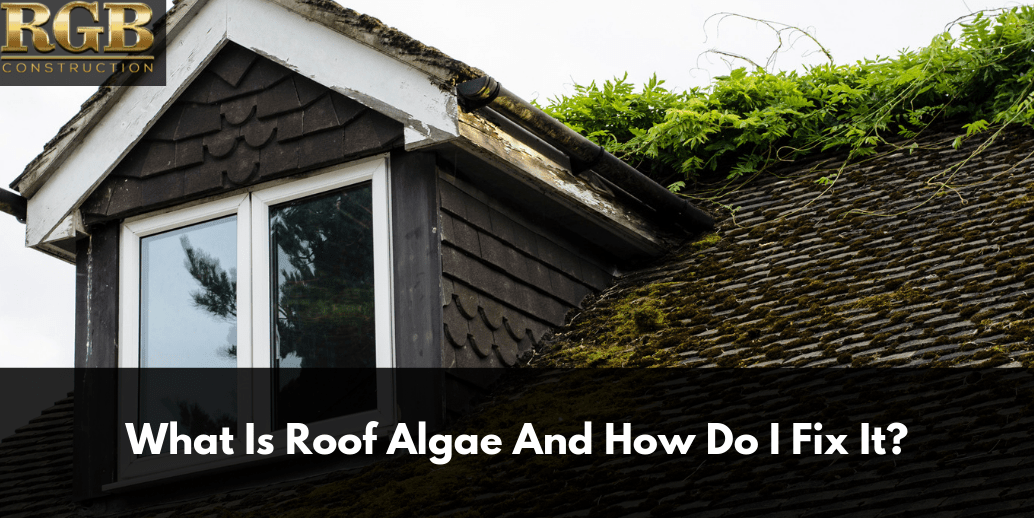Dirt, sticks, leaves, snow, and ice are not the only things that can build up on the roof of your home. Although those items should be removed to avoid harm to your shingles, there is another type of buildup that can be even more damaging. What many people call “roof mold” is actually a blue-green type of algae that leaves dark stains when it dies. Roof algae, lichens or fungi continue to worsen each year unless you have it professionally cleaned, posing a hazard to your home.
What Does Roof Algae Look Like?
In most cases, roof algae will look like discoloration on your roofing material. It may be black stains or streaks or you may see a green, mossy growth. There could also be white spots or round lichens on your roof. Because it often looks like spots of mold, many people think that roof algae is a type of mold or mildew. It is possible for mold to grow if water gets trapped in the materials but it is more likely you are dealing with algae than mold on your roof. There are differences between algae and mold. Algae is not dangerous to humans but can overtake your roof within four years with the right conditions. It is not possible to deal with roof algae on your own. You need to reach out to a professional roofing contractor to recommend the best steps to eliminate the problem.
Causes of Roof Algae
Algae is an aquatic plant that does not have a root system or leaves. If your home is in a humid atmosphere where heat and moisture combine, algae can thrive. Algae grow quickly in areas that are shady and damp, an issue you may face if your home is surrounded by trees. In order to grow, algae needs nutrients which may be provided by the limestone filler found in roofing shingles. Other inorganic materials in your roof help the algae to spread and darken. An algae growth on your roof can begin with one single spore that has been blown onto your roof. If conditions are right, the spore will attach and spread. Rainy weather can promote algae growth but if the air is humid, the plant does not need rain to grow. Other factors like clogged gutters, standing water or poor roof ventilation can also promote algae growth.
Types of Roof Algae
Roof algae is usually a black-green color and it normally grows on wood and asphalt shingles, although it may grow on concrete tiles if they are not exposed to sunlight. The most common type is Gloeocapsa magma, a type of roof bacteria that feeds on water and expels oxygen. The black stains on your roof are buildups of the algae that prevent the sun from burning off the bacteria the algae uses for food. Roof lichen, a combination of algae and fungus, may also be causing the discoloration on your roof. Lichens contain roots that will attach securely to your shingles, making them difficult to remove. Lichen, left untreated, can actually remove the top layer of the shingle, causing permanent damage. Roof moss also has roots, known as rhizoids, that can attach to your shingles. The moss then creates a layer of algae and lichen growth by collecting windblown soil and spores.
Dangers of Roof Mold
Roof mold can be very dangerous. It appears as brown or black blotches and often has an unpleasant odor. Mold grows where the roof has absorbed water. Mildew, similar to mold, can also grow on your roof in areas where the surface is damp. Mildew appears powdery and can range from black to pink. Both mold and mildew can be very dangerous, especially for those who suffer from allergies and asthma. However, all types of roof bacteria can pose threats to your roof, home and health.
How Algae Can Affect Your Roof
Unlike mold, mildew and other types of bacteria, algae is primarily a visual problem. Roof algae can reduce the curb appeal of your home. In addition, roof algae could indicate significant damage to your roofing system because it is difficult to tell the difference between, algae, mold, mildew, lichens and moss. If the moisture sinks into he wood of the roof, repairs can become extremely expensive. Standing water can soften the wood, compromising its strength and structure. Allowing an algae or mold buildup to remain on your roof could force you to replace the underlayment which can be very expensive. Spores can also spread to other structures on your property as well as to your neighbor’s roof.
Eliminating Roof Algae
It is impossible to totally prevent roof algae if you live in a humid or damp climate. There is no way to keep the wind from depositing spores on your roof but you can prevent them from growing. Trim back overhanging branches to increase sunlight on your roof which prohibits algae growth. Be sure to clean your gutters and remove debris from your roof as quickly as possible. If you live in an area where algae growth is prominent, consider using algae-resistant roofing systems or treat your shingles with specially designed moisture-resistant chemicals. If you have already noticed algae or mold on your roof, you should not attempt to correct the problem on your own. Contact a professional roofing contractor who will have the tools necessary to manage your algae problem.
If you have noticed dark spots on your roof, contact RGB Construction today to learn how they can help. You can reach them by calling 856-264-9093 or fill out the easy online form.







